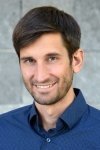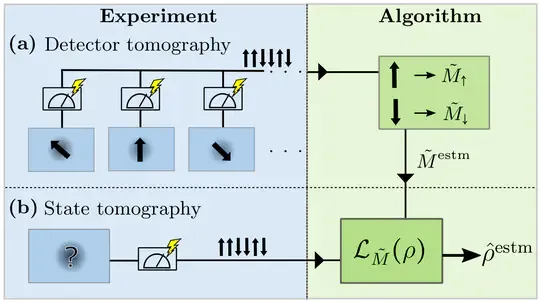
Prof. Martin Gärttner.
Image: Anne Günther (University of Jena)Prof. Dr. Martin GÄRTTNER
Email: martin.gaerttner@uni-jena.de
Phone: +49 3641 9-47180
Martin Gärttner is Professor of Quantum Information Theory at IFTO. The central goal of his research is to use synthetic quantum system as physical simulation devices to explore quantum many-body phenomena. This requires the development of methods for benchmarking these devices using tools from quantum information theory and machine learning. Specifically, the Gärttner group focusses on the efficient characterization of quantum states from measurements, for example quantifying their entanglement, and for simulating quantum many-body physics on classical computers, thereby pushing the limits of numerical methods.
Research Areas
Emerging quantum technology will potentially transform important technological areas such as computing, communication, and sensing. What fascinates us as physicists is that many phenomena that arise when many particles interact at the quantum level are still poorly understood. Nevertheless these phenomena, such as entanglement, are what actually makes quantum devices potentially so powerful, and their better understanding is thus key. Towards this goal we develop analytical and numerical tools to model and simulate quantum many-body systems and search for efficient ways to prepare and probe interesting quantum states of matter.
The Gärttner group focusses on
- Efficient methods to extract information form data generated by quantum simulation experiments, for example entanglement detection or quantum state tomography
- Machine learning assisted ab-initio methods for simulating the dynamics of strongly interacting quantum many-body systems
- Thermalization of closed quantum systems, specifically of disordered spin systems
Teaching Fields
Martin Gärttner gives specialized lectures on Quantum Information Theory, Quantum Technology, Quantum Computing, and Computational Methods in Quantum Physics. His teaching is research oriented and he includes interactive elements like quizzes and small programming exercises in his lectures.
Research Methods
We use and develop many different numerical techniques for simulating the dynamics of quantum many-body systems. This includes exact diagonalization and semiclassical methods like the truncated Wigner approximation, but also variational methods using neural networks to approximate quantum many-body states.
To improve the readout of quantum devices we develop entanglement witnesses, and use detector tomography and quantum state tomography, combined with Bayesian methods for parameter estimation.
Recent Research Results
Machine learning for complex quantum systems
Artificial neural networks have proven extremely successful for machine learning tasks such as computer vision and speech recognition. In quantum many-body physics they can help speeding up ab-initio simulations or processing of data from quantum experiments. For instance, generative models can be trained to approximate probability distributions based on data samples. Quantum states are represented by high-dimensional probability distributions, inviting the use of generative models for finding efficient state representations. We use this approach to develop numerical tools for calculating the time evolution of quantum many-body states and to do quantum state tomography.
The image shows a scheme for efficiently extracting entanglement entropies from quantum measurements using supervised learning [ArXiv 2309.07556 (2023)].
Picture: Moritz Reh, Gärttner groupEntanglement detection
Entanglement, which Erwin Schrödinger coined the characteristic treat of quantum mechanics, is the resource that renders many quantum technology superior to their classical counterparts. At the same time entanglement is at the heart of many physical phenomena. For example, it explains why interacting quantum systems, even when perfectly isolated from their environment, can relax to thermal equilibrium. Thus, techniques for detecting and quantifying entanglement based on experimental data are direly needed. We develop such techniques taking into account the concrete measurement capabilities of quantum simulation platforms including cold atoms and photonic systems.
The image shows a scheme for detecting high dimensional entanglement in experiments with cold atoms in optical lattices [ArXiv 2305.07413 (2023)].
Picture: Niklas Euler, Gärttner groupThermalization in disordered spin systems
Disorder is present in many natural systems from glasses and amorphous solids to social networks with seemingly random connections. Such systems often show surprising emergent dynamical effects. In the realm of quantum many-body systems disorder can lead to hierarchical relaxation and glassy behavior. We study relaxation dynamics and transport in quantum spin systems where the inter-particle interactions are to some degree random. Such systems can be realized by cold atoms excited to Rydberg states. In these highly excited states the atoms interact via strong dipole-dipole interactions. We model these systems numerically and try to come up with new ways for experimentally probing their properties.
The image shows a chain of randomly positioned spins with power-law decaying interactions. The random couplings lead to an effective pairing of spins, which results in an emergent prethermal phase and many-body localization [Phys. Rev. B 106, 134212 (2022)].
Picture: Adrian Braemer, Gärttner groupQuantum tomography
Quantum measurements are distinctly different from classical ones in that they inevitably affect the state of the system to some degree. This leads to subtleties when trying to characterize quantum states from experimental data, a highly relevant task for quantum technology. We design measurement strategies that allow characterizing quantum state in a maximally sample efficient way using a feedback loop. We also investigate how to correct experimental errors occurring during the readout process though post-processing of the measurement data.
The image shows a scheme for mitigating errors occurring in the readout process of quantum devices through detector tomography.
Image: Image: Adrian Aasen, Gärttner group
![The image shows a scheme for efficiently extracting entanglement entropies from quantum measurements using supervised learning [ArXiv 2309.07556 (2023)].](https://www.acp.uni-jena.de/acpmedia/14575/gaerttner-image-ml-for-quantum.webp?height=316&width=540)
![The image shows a scheme for detecting high dimensional entanglement in experiments with cold atoms in optical lattices [ArXiv 2305.07413 (2023)].](https://www.acp.uni-jena.de/acpmedia/14564/gaerttner-image-entangement-detection.webp?height=427&width=760)
![The image shows a chain of randomly positioned spins with power-law decaying interactions. The random couplings lead to an effective pairing of spins, which results in an emergent prethermal phase and many-body localization [Phys. Rev. B 106, 134212 (2022)].](https://www.acp.uni-jena.de/acpmedia/14553/gaerttner-image-disordered-spin-systems.webp?height=295&width=540)
